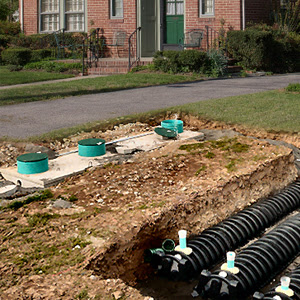Many people are familiar with what a septic tank is and its functionalities. However, when it comes to other septic systems involved such as the drainfield, few people have an idea of how it works. A leach field can also be referred to as the drainfield. Knowing the importance of a drainfield to the septic system will allow homeowners and community members to identify problems that may occur. To fix issues, drainfield maintenance can be done.
Understanding how a drainfield works will allow a person to know how to lengthen the longevity of their septic system and save them a lot of money. It is also important to take note that the drainfield is also the most expensive component of the septic system.
A normal drainfield is made of three main components namely the aggregate, the perforated pipe, and good soil. If one component has a problem, it is best to conduct drainfield maintenance. The pipe’s task is to receive the effluent which is the waste coming from the septic tank. The pipe distributes the effluent on the aggregate as it trickles to the soil. The soil will be the one to filter out any harmful bacteria that was carried on the effluent before reintroducing it back to a water table.
Once the septic tank is done with its task of breaking down the waste, it will flow to the drainfield. The effluent is evenly distributed to the perforated pipes. Perforate pipes have holes near the bottom. These pipes go a long way as the length of the drainfield. The effluent spills out from the pipes into the field. When the effluent leaves the perforated pipe, it goes to the aggregate. An aggregate is made up of stone. The aggregate’s purpose is to allow the even dispersal of the effluent for an equal absorption in the soil.
The soil serves as the main foundation of a well-functioning drainfield. Once a septic system is installed, the first step is to have a health department representative run tests and check if the soil would be good enough. Having sandy soil means that the effluent will drain well. Clay-like soils will not drain very well which may need a larger drainfield that will compensate for the soil’s lack of good drainage capabilities. The tests done include digging test pits and doing a percolation test.
The best way to fully understand how a drainfield functions is to compare it with a sponge. As the sponge fills water but if it gets too wet, the water will flow. The drainfield gets filled in sludge, and over time, it will lose the ability to hold water. The water moves upward and flows out. This is why effective leach field maintenance is needed to put the remedy in situations where the drainfield had too much water.
A drainfield is affected by too much water going into it. Going back to the sponge comparison, if the sponge keeps getting water without any squeezing, the water will overflow which will lead to the sponge as unusable. To use it again, it has to be squeezed or dried out. Too much water on the drainfield will make it harder to keep up with the excess wastewater.
This is why it is very essential to ensure that a household does not overuse water more than they need. Excessive water use will speed up malfunctions in the drainfield. Some major issues involve often back-flushing or have a sump pump that is directed to the sewer line. Sump pumps can be dangerous especially during heavy rainfall as they will add more water to the basement. If possible, homeowners should avoid excessive water. If unavoidable do not use too much water to prolong the septic system.
Many heavy rainfalls can lead to permanent damage to the drainfield and the septic system. Homeowners must look into problematic faucets or toilets. It is recommended for the condensate line from the air condition unit will not enter the sewer line. A small daily trickle can accumulate over a long time. To avoid a long-term problem with the system, a septic system and drainfield maintenance must be scheduled to address the problems before it gets out of hand.


Keep sharing such helpful blogs. We offer septic drain field installation and repair in Spruce Grove AB, Fort Saskatchewan, Edmonton, Alberta. Contact us for septic tank field repair, septic line replacement and installation.
ReplyDeleteinstalling a cistern for drinking water